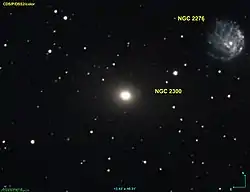| NGC 2300 | |
|---|---|
 NGC 2300 next to nearby galaxy NGC 2276 | |
| Observation data (J2000[1] epoch) | |
| Constellation | Cepheus |
| Right ascension | 07h 32m 20.5s[1] |
| Declination | +85° 42′ 31.9″[1] |
| Redshift | 0.00641[1] |
| Heliocentric radial velocity | 1,917 km/s[1] |
| Apparent magnitude (V) | 10.76[2] |
| Absolute magnitude (V) | −22.0[2] |
| Characteristics | |
| Type | SA00[2] |
| Other designations | |
| PGC 21231, APG 114, UGC 3798, MCG +14-04-031, 2MASS J07322048+8542319[3][1] | |
NGC 2300 is a lenticular galaxy in the constellation Cepheus.[4] It was discovered in 1871 by French astronomer Alphonse Borrelly using an 18 cm telescope.[3]
See also
References
- 1 2 3 4 5 6 "NGC 2300". SIMBAD. Centre de données astronomiques de Strasbourg. Retrieved 2019-02-25.
- 1 2 3 "Results for object NGC 2300 (NGC 2300)". NASA/IPAC Extragalactic Database. California Institute of Technology. Retrieved 2021-02-26.
- 1 2 "New General Catalog Objects: NGC 2300 - 2349". cseligman.com. Retrieved 2019-02-25.
- ↑ "Your NED Search Results". ned.ipac.caltech.edu. Retrieved 2019-02-25.
External links
 Media related to NGC 2300 at Wikimedia Commons
Media related to NGC 2300 at Wikimedia Commons- NGC 2300 on WikiSky: DSS2, SDSS, GALEX, IRAS, Hydrogen α, X-Ray, Astrophoto, Sky Map, Articles and images
- SEDS
This article is issued from Wikipedia. The text is licensed under Creative Commons - Attribution - Sharealike. Additional terms may apply for the media files.